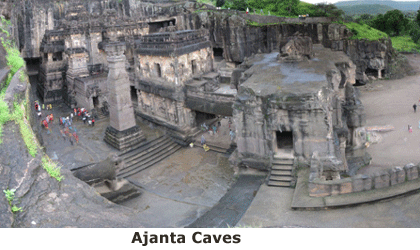AJANTA CAVES................................................................................................................................................................................................................................................................................... The famous Ajanta caves are situated about 99-kms away from Aurangabad district in the state of Maharashtra. These caves are regarded as a world heritage site and were carved out from the 2nd century BC to 6th century AD. They are placed in a horseshoe shape about 3.5 m away from the village. The river Wagura, a mountain stream flows along the bottom of the ravine. This river falls from a height of 200 ft, thus making a series of waterfalls. The sound of the waterfalls can be heard in the caves also. The intriguing Ajanta Caves are carved out of large rocks and are 30 in number. These caves are dedicated to Lord Buddha. The followers and students of Buddhism resided here to study this religion. They have decorated these caves with the help of their excellent architectural skills and artistic paintings. The carvings and the paintings in the caves depict the life stories of Lord Buddha. Along with this, several types of human and animal figures are also carved out of the rocks. Depiction of Contemporary Society The carvings and the murals in the Ajanta depicted the contemporary society of that period. These artistic pieces showed all kinds of people from kings to slaves, women, men and children interwoven with flowers, plants, fruits, birds and beasts. There are also figures related to the people of that time, some of them are 'Yakshas', 'Kinneras' (half human and half bird) 'Gandharvas' (divine musicians) and 'Apsaras' (heavenly dancers). Discovery The enchanting Ajanta caves were discovered accidentally by a company of British soldiers in the 19th century. Before the excavation of these caves they were hidden under the thick vegetation for a long time. Caves The incredible caves of Ajanta are dedicated exclusively to Buddhism. There are around 30 caves here and are divided into 'Chaitya-Grihas' (stupa halls) and 'Viharas' (dwelling halls). Around five of these caves (9, 10, 19, 26 and 29) are 'Chaitya-Grihas'. The rest of the caves are 'Sangharamas' or Viharas (monasteries). The caves 1, 2, 16 and 17 are important from the art point of view. They are great pieces of art compared to the contemporary art world. These caves have exotic paintings illustrating the life and incarnations of Buddha. The carvings and the paintings of the Ajanta caves tell us about the imagination and creativity of the artist. The murals on the walls of these caves are still in a good condition, maintaining the freshness of the color and spreading vibrancy in the atmosphere. Visitors will definitely enjoy watching these great historical pieces of art. Viharas The Ajanta caves were divided into several viharas (dwelling halls) and chaitya-grihas (stupa halls), scooped out of the sloping rocks in the fifth century CE. The viharas consisted of a broad verandah. The roof of this verandah was supported by pillars and giving towards the interior on to a hall averaging in size about 35 ft. by 20 ft. Also there are dormitories to the left, right and back , opening on to this hall. The number of dormitories varied according to the size of the hall, and in the larger ones pillars supported the roof on all three sides, forming a sort of religious residence running round the hall. There is also a shrine of lord Buddha in a niche facing the entrance and sometimes facing the subsidiary shrines to the right or left of the entrance. With the help of carvings, the facades of the viharas were decorated and the paintings adorned the walls and ceilings. Chaityas The chaitya-grihas are greater than
the viharas. The largest chaitya-grihas being 94 1/2 ft. from the verandah to
the back and 41 1/4 ft. across, including the cloister. Earlier, the
chaitya-grihas at Ajanta had stupas, but later they had a standing or seated
image of the Buddha in front of them. Wall-Paintings The Ajanta caves are divided into three groups. The oldest group is believed to belong to the period between 200 BCE to CE 200, the second group is believed to belong to the sixth and the third group to the seventh century. Almost all the interior walls and ceilings of the caves are covered with murals. At the time of discovery (1817), these paintings were in a better condition than now. But fortunately, the school of art in Bombay has the copied versions of the paintings which have now disappeared from the caves. These copies are the major evidence of pictorial art in India before the rise of Hinduism. Thus, they are valuable and need preservation. |
|||||||
|
|
|||||||




